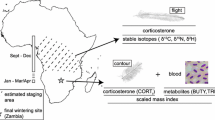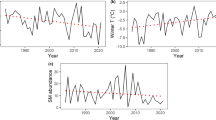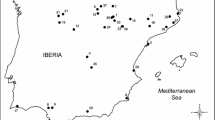Abstract
The hypothesis that migratory bird populations are limited during the non-breeding season is increasingly supported by empirical studies that also suggest consequences that carry-over into subsequent seasons. Although variation in food supply is the best supported explanation for non-breeding season limitation, the ecological mechanisms and physiological consequences are not well understood. We both supplemented and reduced Ovenbird (Seiurus aurocapilla) food availability on replicate plots in Jamaica in each of 3 years to determine the direct role of food in limiting the physical condition of Ovenbirds. Annual variation in rainfall and food supply created a natural experiment in parallel with manipulations. Sex and age-classes of Ovenbirds did not respond differently in terms of body condition to either food manipulation or natural variation in environmental conditions, suggesting that this population is not structured by strong dominance relationships. Ovenbird body mass, fat, and pectoralis muscle shape were positively and predictably related to manipulated food availability. Feather regrowth rate also responded positively to food supplementation and negatively to food reduction in the drier of 2 years. Prior to manipulation, annual variation in body mass corresponded to annual variation in food supply and rainfall, providing additional, correlational evidence of food limitation. Since multiple intercorrelated body condition indices of Ovenbirds responded directly to food supply, and since food supply influenced body condition independently of other habitat features, we argue that food is a primary driver of non-breeding season population limitation. Moreover, since these effects were observed during the late non-breeding period, when individuals are preparing to migrate, we infer that food availability likely initiates carry-over effects.






Similar content being viewed by others
References
Agosti D, Alonso LE, Schultz TR (2000) Ants: standard methods for measuring and monitoring biodiversity. Smithsonian Institution Press, Washington, D.C.
Bearhop S, Hilton GM, Votier SC, Waldron S (2004) Stable isotope ratios indicate that body condition in migrating passerines is influenced by winter habitat. Proc R Soc Lond [Suppl] 271:215–218
Brown DR (2006) Food supply and the dry-season ecology of a tropical resident bird community and an over-wintering migrant bird species. PhD Dissertation, Tulane University, New Orleans, Louisiana
Brown DR, Sherry TW (2006) Behavioral response of Jamaican resident birds to food manipulation. Biotropica 38:91–99
Brown DR, Strong CM, Stouffer PC (2002) Demographic effects of habitat selection by Hermit Thrushes in a pine plantation landscape. J Wildl Manage 66:407–416
Brown ME (1996) Assessing body condition in birds. Curr Ornithol 13:67–135
Cherel Y, Robin JP, Le Maho Y (1988) Physiology and biochemistry of long-term fasting in birds. Can J Zool 66:159–166
Dugger KM, Faaborg J, Arendt WJ, Hobson KA (2004) Understanding survival and abundance of overwintering warblers: does rainfall matter? Condor 106:744–760
Ellegren H (1996) First gene on the avian W chromosome (CHD) provides a tag for universal sexing of non-ratite birds. Proc R Soc Lond B 263:1635–1641
Garcia-Berthou E, (2001) On the misuse of residuals in ecology: testing regression residuals vs. the analysis of covariance. J Anim Ecol 70:708–711
Gosler AG (1991) On the use of greater covert moult and pectoral muscle as measures of condition in passerines with data for the Great Tit Parus major. Bird Study 38:1–9
Griffiths R, Daan S, Dijkstra C (1996) Sex identification in birds using two CHD genes. Proc R Soc Lond B 263:251–1256
Grubb TC (1989) Ptilochronology: feather growth bars as indicators of nutritional status. Auk 106:314–320
Guglielmo CG, O’Hara PD, Williams TD (2002) Extrinsic and intrinsic sources of variation in plasma lipid metabolites of free-living western sandpipers. Auk 119:437–445
Hurlbert SH (1984) Pseudoreplication and the design of ecological field experiments. Ecol Monogr 54:187–211
Lefebvre G, Poulin B, McNeil R (1994) Temporal dynamics of mangrove bird communities in Venezuela with special reference to migrant warblers. Auk 111:405–415
Jenni-Eiermann S, Jenni L (1996) Metabolic differences between the postbreeding moulting and migratory periods in feeding and fasting passerine birds. Funct Ecol 10:62–72
Jenn-Eiermann S, Jenni L (1997) Diurnal variation of metabolic responses to short-term fasting in passerine birds during the postbreeding, molting and migratory period. Condor 99:113–122
Johnson MD, Sherry TW (2001) Effects of food availability on the distribution of migratory warblers among habitats in Jamaica. J Anim Ecol 70:546–560
Johnson MD, Strong AM (2000) Length–weight relationships of Jamaican arthropods. Entomol News 111:270–281
Johnson, MD, Sherry TW, Holmes RT, Marra PP (2006) Assessing habitat quality for a migratory songbird wintering in natural and agricultural habitats. Conserv Biol (in press)
Levings SC (1983) Seasonal, annual, and among-site variation in the ground ant community of a deciduous tropical forest: some causes of patchy species distributions. Ecol Monogr 53:435–455
Macleod R, Barnett P, Clark JA, Cresswell W (2005) Body mass change strategies in blackbirds (Turdus merula): the starvation-predation risk trade-off. J Anim Ecol 74:292–302
McNamara JR, Houston AI (1990) The value of fat reserves and the trade-off between starvation and predation. Acta Biotheror 38:37–61
Marra PP, Holberton RL (1998) Corticosterone levels as indicators of habitat quality: Effects of habitat segregation in a migratory bird during the nonbreeding season. Oecologia 116:284–292
Marra PP, Holmes RT (2001) Consequences of dominance-mediated habitat segregation in American Redstarts during the nonbreeding season. Auk 118:92–104
Marra PP, Hobson KA, Holmes RT (1998) Linking winter and summer events in a migratory bird by using stable-carbon isotopes. Science 282:1884–1886
Newton I (2004) Population limitation in migrants. Ibis 146:197–226
Norris DR, Marra PP, Kyser TK, Sherry TW, Ratcliffe LM (2004a) Tropical winter habitat limits reproductive success on the temperate breeding grounds in a migratory bird. Proc R Soc Lond B 271:59–64
Norris DR, Marra PP, Montgomerie R, Kyser TK, Ratcliffe LM (2004b) Reproductive effort, molting latitude, and feather color in a migratory songbird. Science 306:2249–2250
Oksanen L, (2001) Logic of experiments in ecology: is pseudoreplication a pseudoissue? Oikos 94:27–38
Poulin B, Lefebvre G (1996) Dietary relationships of migrant and resident birds from a humid forest in central Panama. Auk 113:227–287
Pyle P (1997) Identification guide to North American birds. Slate Creek Press, Bolinas
Rappole JH (1995) The ecology of migrant birds: a Neotropical perspective. Smithsonian Institution Press, Washington, D.C.
Rappole JH, King DI, Diez J (2003) Winter- vs. breeding-habitat limitation for an endangered avian migrant. Ecol Appl 13:735–742
Redfern CPF, Clark JA (2001) Ringers’ manual. British Trust for Ornithology, Thetford, UK
Rogers CM (1987) Predation risk and fasting capacity: do wintering birds maintain optimal boddy mass? Ecology 68:1051–1061
Rogers CM (1991) An evaluation of the method of estimating body fat in birds by quantifying visible subcutaneous fat. J Field Ornithol 62:349–356
Rogers CM (2005) Food limitation among wintering birds: a view from adaptive body mass models. In: Greenberg R, Marra PP (eds) Birds of two worlds. Johns Hopkins University Press, Baltimore, pp 106–113
Saino N, Szep T, Romano M, Rubolini D, Spina F, Moller AP (2004) Ecological conditions during winter predict arrival date at the breeding quarters in a trans-Saharan migratory bird. Ecol Lett 7:21–25
Sherry TW, Holmes RT (1995) Summer versus winter limitation of populations: what are the issues and what is the evidence? In: Martin TE, Finch DM (eds) Ecology and management of neotropical migratory birds. Oxford University Press, New York, pp 85–120
Sherry TW, Johnson MD, Strong AM (2005) Does winter food limit populations of migratory birds? In: Greenberg R, Marra PP (eds) Birds of two worlds. Johns Hopkins University Press, Baltimore, pp 414–425
Sillett TS, Holmes RT, Sherry TW (2000) The El Niño Southern oscillation impacts population dynamics of a migratory songbird throughout its annual cycle. Science 288:2040–2042
Strong AM (2000) Divergent foraging strategies of two neotropical migrant warblers: Implications for winter habitat use. Auk 117:381–392
Strong AM, Sherry TW (2000) Habitat-specific effects of food abundance on the condition of ovenbirds wintering in Jamaica. J Anim Ecol 69:883–895
Studds CE, Marra PP (2005) Winter habitat quality and population processes: an upgrade experiment with a migratory bird. Ecology 86:2380–2385
Van Horn MA, Donovan TM (1994) Ovenbird. In: Poole A, Gill F (eds) The birds of North America, No. 88. The Academy of Natural Sciences, Philadelphia and The American Ornithologists’ Union, Washington, D.C., pp 1–22
Wilkinson L (2000) systat 10.0 for windows. SPSS Inc, Chicago, Ill.
Williams TD, Guglielmo CG, Egeler O, Martyniuk CJ (1999) Plasma lipid metabolites provide information on mass change over several days in captive Western Sandpipers. Auk 116:994–1000
Zach R, Falls B (1978) Prey selection by captive ovenbirds (Aves: Parulidae). J Anim Ecol 47:929–943
Acknowledgements
This research was supported by National Science Foundation (NSF) grants to T.S. and P. Marra (DEB-0089541), and an NSF Doctoral Dissertation Improvement Grant to D.B. and T.S. Additional financial support was provided by a Sigma-Xi grant in aid of research and a Frank. M. Chapman grant from the American Museum of Natural History. We thank A. Anderson, L. Duda, A. Flowers, L. Foerster, R. Kaler, G. Levandoski, A. Orahoske, and C. Studds for diligent field assistance. For molecular sexing, we are grateful to M. White for use of laboratory facilities at Southeastern Louisiana University, and M. Brown for lab assistance. P. and M. Gordon, and A. and T. Williams provided warm hospitality during our field stays. We thank L. Dyer, R. Holberton, J. Long, P. Marra, A. Strong, C. Studds, and two anonymous reviewers for helpful suggestions on the manuscript. This work was approved by the Tulane IACUC, and conducted under necessary United States and Jamaican government bird banding and handling, and import/export permits.
Author information
Authors and Affiliations
Corresponding author
Additional information
Communicated by Blair Wolf
Rights and permissions
About this article
Cite this article
Brown, D.R., Sherry, T.W. Food supply controls the body condition of a migrant bird wintering in the tropics. Oecologia 149, 22–32 (2006). https://doi.org/10.1007/s00442-006-0418-z
Received:
Accepted:
Published:
Issue Date:
DOI: https://doi.org/10.1007/s00442-006-0418-z




